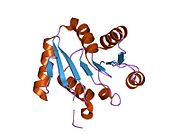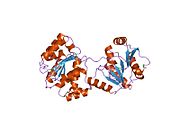Biology:BAT1
 Generic protein structure example |
Spliceosome RNA helicase BAT1 is an enzyme that in humans is encoded by the BAT1 gene.[1][2][3]
This gene encodes a member of the DEAD box family of RNA-dependent ATPases that mediate ATP hydrolysis during pre-mRNA splicing. The encoded protein is an essential splicing factor required for association of U2 small nuclear ribonucleoprotein with pre-mRNA, and also plays an important role in mRNA export from the nucleus to the cytoplasm. A cluster of genes, BAT1-BAT5, is localized in the vicinity of the genes for TNF alpha and TNF beta. These genes are all within the human major histocompatibility complex class III region. Mutations in this gene may be associated with rheumatoid arthritis. Alternatively spliced transcript variants encoding the same protein have been described.[3]
References
- ↑ "The BAT1 gene in the MHC encodes an evolutionarily conserved putative nuclear RNA helicase of the DEAD family". Genomics 26 (2): 210–8. Aug 1995. doi:10.1016/0888-7543(95)80203-X. PMID 7601445.
- ↑ "Human major histocompatibility complex contains a minimum of 19 genes between the complement cluster and HLA-B". Proc Natl Acad Sci U S A 86 (22): 8955–8. Dec 1989. doi:10.1073/pnas.86.22.8955. PMID 2813433. Bibcode: 1989PNAS...86.8955S.
- ↑ 3.0 3.1 "Entrez Gene: BAT1 HLA-B associated transcript 1". https://www.ncbi.nlm.nih.gov/sites/entrez?Db=gene&Cmd=ShowDetailView&TermToSearch=7919.
External links
- Human DDX39B genome location and DDX39B gene details page in the UCSC Genome Browser.
- PDBe-KB provides an overview of all the structure information available in the PDB for Human Spliceosome RNA helicase DDX39B (BAT1)
Further reading
- "A new cluster of genes within the human major histocompatibility complex.". Science 243 (4888): 214–7. 1989. doi:10.1126/science.2911734. PMID 2911734. Bibcode: 1989Sci...243..214S.
- "Purification of CpG islands using a methylated DNA binding column.". Nat. Genet. 6 (3): 236–44. 1994. doi:10.1038/ng0394-236. PMID 8012384.
- "Oligo-capping: a simple method to replace the cap structure of eukaryotic mRNAs with oligoribonucleotides.". Gene 138 (1–2): 171–4. 1994. doi:10.1016/0378-1119(94)90802-8. PMID 8125298.
- "U2AF65 recruits a novel human DEAD box protein required for the U2 snRNP-branchpoint interaction.". Genes Dev. 11 (14): 1864–72. 1997. doi:10.1101/gad.11.14.1864. PMID 9242493.
- "Construction and characterization of a full length-enriched and a 5'-end-enriched cDNA library.". Gene 200 (1–2): 149–56. 1997. doi:10.1016/S0378-1119(97)00411-3. PMID 9373149.
- "Characterisation of the human central MHC gene, BAT1: genomic structure and expression.". Exp. Clin. Immunogenet. 16 (2): 98–106. 1999. doi:10.1159/000019100. PMID 10343160.
- "A second susceptibility gene for developing rheumatoid arthritis in the human MHC is localized within a 70-kb interval telomeric of the TNF genes in the HLA class III region.". Genomics 71 (3): 263–70. 2001. doi:10.1006/geno.2000.6371. PMID 11170743.
- "The central MHC gene, BAT1, may encode a protein that down-regulates cytokine production.". Genes Cells 6 (5): 487–94. 2001. doi:10.1046/j.1365-2443.2001.00435.x. PMID 11380625.
- "Pre-mRNA splicing and mRNA export linked by direct interactions between UAP56 and Aly.". Nature 413 (6856): 644–7. 2001. doi:10.1038/35098106. PMID 11675789. Bibcode: 2001Natur.413..644L.
- "Directed proteomic analysis of the human nucleolus.". Curr. Biol. 12 (1): 1–11. 2002. doi:10.1016/S0960-9822(01)00650-9. PMID 11790298.
- "TREX is a conserved complex coupling transcription with messenger RNA export.". Nature 417 (6886): 304–8. 2002. doi:10.1038/nature746. PMID 11979277. Bibcode: 2002Natur.417..304S.
- "Generation and initial analysis of more than 15,000 full-length human and mouse cDNA sequences.". Proc. Natl. Acad. Sci. U.S.A. 99 (26): 16899–903. 2003. doi:10.1073/pnas.242603899. PMID 12477932. Bibcode: 2002PNAS...9916899M.
- "An evolutionarily conserved role for SRm160 in 3'-end processing that functions independently of exon junction complex formation.". J. Biol. Chem. 278 (45): 44153–60. 2004. doi:10.1074/jbc.M306856200. PMID 12944400.
- "Yeast two-hybrid screens imply involvement of Fanconi anemia proteins in transcription regulation, cell signaling, oxidative metabolism, and cellular transport.". Exp. Cell Res. 289 (2): 211–21. 2003. doi:10.1016/S0014-4827(03)00261-1. PMID 14499622.
- "Regulation of alternative splicing by SRrp86 and its interacting proteins.". Mol. Cell. Biol. 23 (21): 7437–47. 2003. doi:10.1128/MCB.23.21.7437-7447.2003. PMID 14559993.
- "The DNA sequence and analysis of human chromosome 6.". Nature 425 (6960): 805–11. 2003. doi:10.1038/nature02055. PMID 14574404. Bibcode: 2003Natur.425..805M.
- "Analysis of a high-throughput yeast two-hybrid system and its use to predict the function of intracellular proteins encoded within the human MHC class III region.". Genomics 83 (1): 153–67. 2004. doi:10.1016/S0888-7543(03)00235-0. PMID 14667819.
- "Polymorphisms at positions -22 and -348 in the promoter of the BAT1 gene affect transcription and the binding of nuclear factors.". Hum. Mol. Genet. 13 (9): 967–74. 2004. doi:10.1093/hmg/ddh113. PMID 15028669.






